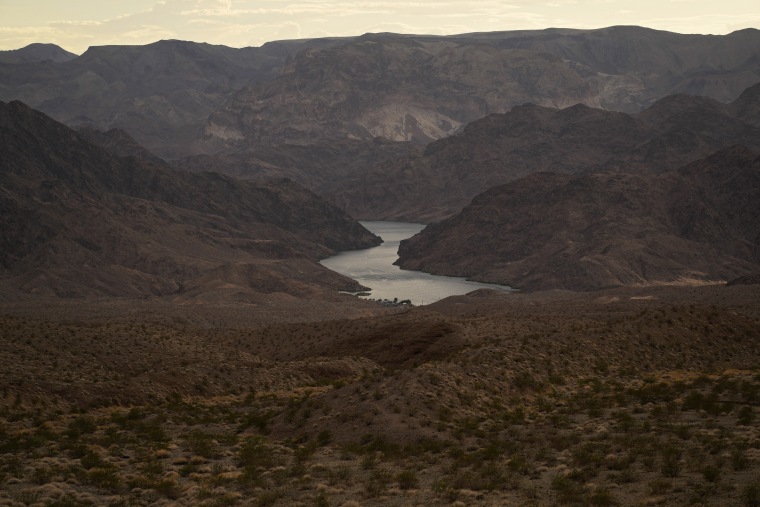The Government of Joe Biden published this Tuesday an analysis of the crisis facing the Colorado River and its plans to deal with the drought by cutting the use of water.
The scenarios he outlines could affect seven West Coast states and tribes that depend on the river, and cities like Los Angeles and Las Vegas.
The Interior Department offers in its draft analysis two different scenarios for how to cut water use in case the levels of Lakes Mead and Powell continue to fall.
On the one hand, California and some Native tribes want to protect their priority rights to the river water, which they use for drinking and farming.
On the other side are Colorado, Nevada, Arizona, Utah, Wyoming and New Mexico, who say the time has come to take an approach that allows for a fairer share.
[“It's very hard to live like this”: Historic drought threatens the farms and livelihoods of an Indian tribe in Colorado]
Cities like Los Angeles, Las Vegas and Phoenix would take the lion's share of water shutoffs if Lake Mead levels continue to drop, as they have a lower priority right to water than farmers and Indian tribes, according to CNN. .
It would deal a heavy blow to those cities;
90% of Las Vegas' water supply comes from the Colorado River, for example, while Phoenix's is around 40%.
The Colorado River below the Hoover Dam in northwestern Arizona, on Aug. 14, 2022. John Locher / AP
This 1,450-mile (2,334-kilometer) river supplies 40 million people in seven Western states: Utah, Wyoming, Colorado, New Mexico, Nevada, Arizona, and California.
It encompasses tribal and Mexican lands, generates regional hydroelectric power, and irrigates nearly six million acres (2,428 hectares) of farmland.
Decade-long drought in the West, exacerbated by climate change, increased demand and overuse, has pushed water levels in major reservoirs along the river to record lows.
Federal officials are hoping that severe storms in recent months in California and the western Rocky Mountains, the main source of water for the Colorado River, will ease the situation this year.
But it's not clear how that amount of rainfall is affecting the negotiations.
"The snow is great.
It's a godsend.
But we have been in a drought for 23 years,” Interior Undersecretary Tommy Beaudreau told The Associated Press news agency.
According to him, he said, the states, indigenous tribes and other water users recognize that nobody is interested in paralyzing the negotiations due to the good situation of the snow cover, at 160% of the average in the upper basin of the Colorado River.
In January, six of the seven states that depend on the Colorado River outlined a plan for how they would conserve more water, but California disagreed.
This state, the largest consumer of the river's water, unveiled its own proposal a day later.
Both plans responded to a call last year by the Bureau of Reclamation, which manages the major dams in the river system, for states to propose how they would reduce their water use by roughly 15% to 30%, in addition to agreed cuts. in recent years.
They each achieve cuts of about two million acre-feet, which is closer to the 15% threshold.
(One acre-foot of water is enough to supply 2-3 American homes a year.)
Main differences
States, tribes and other water users have until May 30 to submit their comments before federal authorities announce their official decision.
Beaudreau gave no indication as to whether his department prefers one approach over the other.
One of the main differences between the two plans is whether states must take into account the enormous amount of water that is lost in the basin through evaporation and infrastructure leaks as it passes through the region's gigantic dams and canals.
Federal authorities claim that more than 10% of the river's water evaporates, seeps, and spills;
however, Arizona, California, Nevada, and Mexico have never accounted for that loss.
California disagreed with that approach.
This is because the state has preemptive rights to the Colorado River water and, due to its location, would lose a significant amount of water if such losses were accounted for.
The further south the river travels, the more water evaporates, which means that if evaporative losses were accounted for, California, Arizona and Mexico would lose more than the northernmost states.
The Quechan tribe, located on the Arizona-California border, also opposes that plan because of their priority water rights.
“We have priority water rights, and last time we checked, we still live in a priority-based system,” said Jay Weiner, attorney for the tribe.
The six states and California also can't agree on when more shutoffs should occur at Lakes Mead and Lake Powell, the country's largest reservoirs.
Arizona and Nevada have more water rights than California, and they supported a plan that shares water cuts amid worsening drought proportionally.
California said it would protect its preferential water rights, which allow it to cut its water supply later, and would likely file legal challenges if the government used the six-state approach.
The claim also did not say how Mexico could contribute to the savings.
The country is entitled to 1.5 million acre-feet of water per year under a treaty reached with the US in 1944. In recent years, it has participated in water-saving plans with the US before worsening drought in both countries.
There is also a third scenario that the feds offered: do nothing.
But neither the states nor the federal government are seriously considering this option, as the Colorado River continues to recede.

